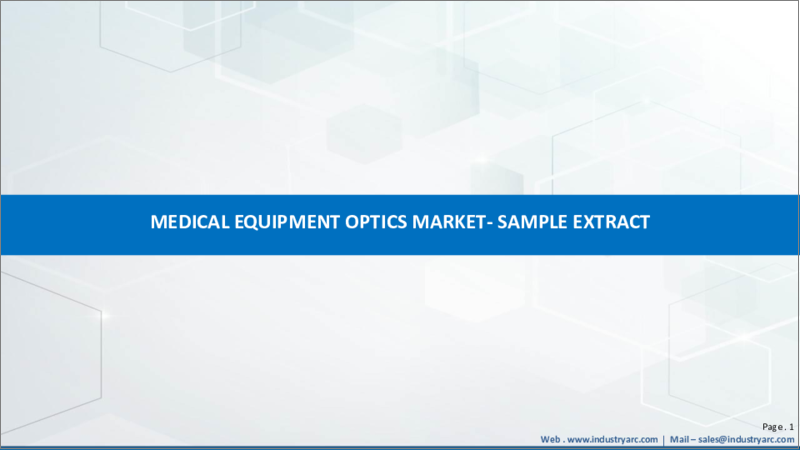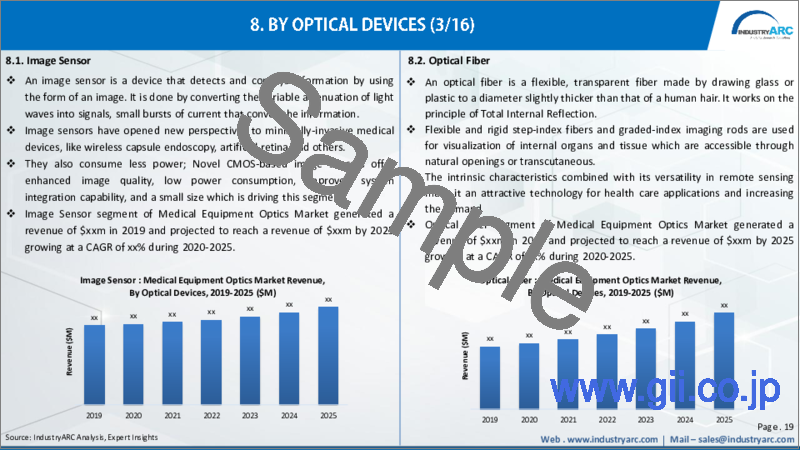|
|
市場調査レポート
商品コード
1099272
医療機器用光学部品の世界市場Medical Equipment Optics Market |
||||||
|
● お客様のご希望に応じて、既存データの加工や未掲載情報(例:国別セグメント)の追加などの対応が可能です。 詳細はお問い合わせください。 |
|||||||
| 医療機器用光学部品の世界市場 |
|
出版日: 2022年06月07日
発行: IndustryARC
ページ情報: 英文 103 Pages
納期: 2~3営業日
|
- 全表示
- 概要
- 目次
医療機器用光学部品の市場規模は予測期間中に5.2%のCAGRで推移し、2026年には207億米ドルの規模に成長すると予測されています。世界の人口増加に伴い、患者の安全確保や診断時の利便性に対する要求が高まっています。世界の医療管理プロバイダーは、より効果的な患者の診断、監視、治癒のため、医療機器用光学部品の進歩に期待しています。
光学性能を向上させたレーザードライバーやトランシーバーの用途が増え、同市場の成長を促進すると予想されています。また、オプトエレクトロニクスの革新も医療機器用光学部品の需要を押し上げると予想されています。光学デバイス別では、内視鏡の部門が2020年に最大のシェアを示しています。呼吸器、消化器、婦人科、泌尿器などの疾患の拡大が内視鏡画像診断の需要を促進し、同部門の成長を後押ししています。また、光ファイバーの部門は、広範なR&Dと技術的進歩やイノベーションの広がりにより、予測期間中に最速のCAGRで成長すると予測されています。
当レポートでは、世界の医療機器用光学部品の市場を調査し、市場の定義と概要、市場成長への各種影響因子の分析、市場規模の推移・予測、各種影響因子の分析、競合情勢、主要企業のプロファイルなどをまとめています。
第1章 医療機器用光学部品市場:概要
第2章 医療機器用光学部品市場:エグゼクティブサマリー
第3章 医療機器用光学部品市場:市場情勢
- 比較解析
- 市場シェア分析:主要企業
- 製品ベンチマーキング:主要企業
- 主要5社の財務分析
- 特許分析:主要企業
- 価格分析
第4章 医療機器用光学部品市場:市場影響因子
- 促進要因
- 抑制要因
- 市場機会
- ポーターのファイブフォースモデル
第5章 医療機器用光学部品市場:戦略的分析
- バリューチェーン分析
- 市場機会の分析
- 製品ライフサイクル
- サプライヤー・ディストリビューターの分析
第6章 医療機器用光学部品市場:光学デバイス別
- イメージセンサー
- 光ファイバー
- ファイバーセンサー
- IRランプ
- UVランプ
- ヘッドミラー
- オトスコープ
- 検眼鏡
- 網膜鏡
- 喉頭鏡
- フォロプター
- 照明ガイド
- ファイバースコープ
- 内視鏡
- LED
- レーザー
- 顕微鏡
- リフレクター
- プリズム
- ミラー
- 金属板
- コンデンサーレンズシステム
- その他
第7章 医療機器用光学部品市場:機器別
- 血糖値計
- 血圧計
- 腹腔鏡
- オプトメーター
- 画像診断
- XRF装置
- 体外診断装置
- CT機器
- コントラスト写真
- 骨濃度計
- 歯科画像システム
- 口腔内カメラ
- 外科機器
- スキンケアデバイス
- 眼科装置
- 医療用線形加速器
- UV消毒
- UV清浄機
- UVライトリアクター
- 空気質測定/清浄機
- 育毛促進装置
- しわ改善装置
- 日焼けマシン
- その他
第8章 医療機器用光学部品市場:地域別
- 北米
- 欧州
- アジア太平洋
- その他
第9章 医療機器用光学部品市場:エントロピー
第10章 医療機器用光学部品市場の企業分析
- 市場シェア・企業収益・製品・M&A・展開
- GE Healthcare
- Medtronic
- Philips Healthcare
- Siemens Healthcare
- Becton Dickinson
- Johnson &Johnson
- Stryker
- B. Braun
- Boston Scientific
Medical Equipment Optics Market size is estimated to reach $ 20.7 billion by 2026, growing at a CAGR of 5.2% during the forecast period 2021-2026. With the expanding population worldwide, there is rising demand for the security of patients and convenience during diagnosis. The global medical management providers are looking forward to making progress in medical instrumentation termed medical equipment optics for more effective patient diagnosis, supervision, and healing. The extensive R&D and the application of optics in medical instruments have resulted in less intrusive methods of healing ailments like substituting surgical intervention with nominally intrusive therapies which is set to drive the medical equipment optics market. Endoscopic imaging is a non-surgical technique utilized to investigate the digestive tract of a patient. Endoscopic imaging is a kind of Medical Equipment Optics that utilizes an endoscope with a malleable tube and a light source to highlight an organ or tissue. Biomedical sensing utilizes biomedical sensors which are particular electronic instruments that may transduce biomedical signals into effortlessly determinable electric signals. Biomedical sensors are based on fiber-optic sensors and therefore fall under Medical Equipment Optics. Photoacoustic imaging permits the transfer of light energy that is consumed by tissues bringing about a thermoelastic augmentation. This augmentation then produces ultrasound waves that are discovered by the transducer and generate images of optical absorption contrast inside tissues. Photoacoustic imaging is termed optoacoustic imaging and is a biomedical imaging modality based on the photoacoustic effect and is included as part of Medical Equipment Optics. Optical coherence tomography (OCT) is an imaging technique, included in Medical Equipment Optics, utilized to produce an image of the back of the eye, termed the retina. The proliferating awareness of medical instruments together with the manner of optical application in them is set to propel the growth of the Medical Equipment Optics Market during the forecast period 2021-2026. This represents the Medical Equipment Optics Industry Outlook.
Report Coverage
The report: "Medical Equipment Optics Market Forecast (2021-2026)", by IndustryARC, covers an in-depth analysis of the following segments of the Medical Equipment Optics Market.
- By Optical Devices: Image Sensor, Optical Fiber, Fiber Sensor, IR Lamps, UV Lamps, Endoscopes, Others.
- By Equipment: Blood Glucose Meters, Blood Pressure Meters, Laparoscope, Optometer, Diagnostic Imaging, XRF Instrument, In-Vitro Diagnostic Equipment, CT Equipment, Contrast Photography, Bone Densitometer, Others.
- By End Users: Hospitals, Clinics, Ambulatory Surgical Centers, Diagnostic Centers Or Laboratories, Research Organizations.
- By Geography: North America (the U.S, Canada, and Mexico), Europe (UK, Germany, France, Italy, Spain, Russia and Rest of Europe), Asia-Pacific (China, India, Japan, South Korea, Australia & New Zealand, and Rest of Asia-Pacific), South America (Brazil, Argentina, Rest of South America) and Rest Of The World (Middle East, Africa).
Key Takeaways
Geographically, North America Medical Equipment Optics Market accounted for the highest revenue share in 2020 and it is poised to dominate the market over the period 2021-2026 owing to the boost in R&D by key players like GE Healthcare in CT, X-Ray, MRI, and Ultrasound imaging and the acceptance of most-recent medical management technologies like endoscopic imaging and biomedical sensing by the health management systems existing in the North American region.
Medical Equipment Optics Market growth is being driven by the technological up-gradation in medical machinery and expanding application areas in the pharmaceutical, biotechnological, medical diagnostics, and therapeutics sectors resulting in increasing acceptance of imaging processes like photoacoustic imaging and biomedical sensing for therapeutic and diagnostic uses and heightening demand for security of patients and convenience during diagnosis. The diverse progressive uses of medical instruments, which affect the temperature, light intensity, pressure, liquid level, chemical, and pH analysis, and the high hazard connected with the intensity of light, utilized for the healing of cancer and ophthalmic ailments is one of the major factors hampering the growth of Medical Equipment Optics Market.
Medical Equipment Optics Market Detailed Analysis on the Strength, Weakness and Opportunities of the prominent players operating in the market will be provided in the Medical Equipment Optics Market report.
Medical Equipment Optics Market Segment Analysis - By Optical Devices:
The Medical Equipment Optics Market based on the product can be further segmented into Image Sensor, Optical Fiber, Fiber Sensor, IR Lamps, UV Lamps, Endoscopes, and Others. The Endoscopes segment held the largest market share in 2020. This growth is owing to the increased use of endoscopes in endoscopic imaging, particularly in the treatment of the elderly, and the raised demand for less intrusive techniques worldwide.The expanding predominance of ailments like respiratory, gastrointestinal, gynecological, and urological ailments is propelling the demand for endoscopic imaging which is driving the growth of the endoscopes segment. Furthermore, the Optical Fiber segment is estimated to grow with the fastest CAGR of 6.5% during the forecast period 2021-2026 owing to the extensive R&D efforts and the proliferating technological advancements and innovations in the Optical Fiber segment.
Medical Equipment Optics Market Segment Analysis - By Equipment:
The Medical Equipment Optics Market based on equipment can be further segmented into Blood Glucose Meters, Blood Pressure Meters, Laparoscope, Optometer, Diagnostic Imaging, XRF Instrument, In-Vitro Diagnostic Equipment, CT Equipment, Contrast Photography, Bone Densitometer, and Others. The Diagnostic Imaging Segment held the largest market share in 2020. This growth is owing to the boost in incessant ailments, particularly in the population of the elderly globally resulting in increased application of techniques like endoscopic imaging to view parts inside the body and make the correct diagnosis. The expanding requirement of physicians to make an objective assessment of how well the body of the patient is responding to the treatment is further set to drive the growth of the diagnostic imaging segment, Furthermore, the In-Vitro Diagnostic Equipment segment is estimated to grow with the fastest CAGR of 6.2% during the forecast period 2021-2026 owing to the proliferating count of cases requiring diverse tests ranging from simple tests on samples like blood and urine samples to sophisticated tests based on DNA technology inclusive of reagents, calibrators, and so on.
Medical Equipment Optics Market Segment Analysis - By Geography:
The Medical Equipment Optics Market based on geography can be further segmented into North America, Europe, Asia-Pacific, South America, and the Rest of the World. North America (Medical Equipment Optics Market) held the largest share with 41% of the overall market in 2020. The growth of this region is owing to the increasing count of innovative product launches and the soaring concentration of key players like Medtronic in the U.S. in the North American region. Rapid strides of advancements is occurring in the different fields of Medical Equipment Optics like endoscopic imaging in this region. For example, in August 2021, FUJIFILM Medical Systems U.S.A., Inc., a chief provider of endoscopic and endosurgical imaging technology, declared the commercial kick-off of the ELUXEO® 7000X System, a novel video imaging technology, the earliest in-market solution, created to authorize real-time visualization of hemoglobin oxygen saturation (StO2) levels in tissue utilizing laparoscopic and/or endoluminal imaging. The ELUXEO 7000X is an enhancement to the company's ELUXEO® Endoscopic Imaging System and these kinds of innovations are driving the growth of the North-American region. Furthermore, the Asia-Pacific region is estimated to be the region with the fastest CAGR rate over the forecast period 2021-2026. This growth is owing to factors like soaring high count of ailments and the boost in the spending on healthcare in the region. The rising efforts in R&D and the favorable policies for progressive healthcare are further fuelling the progress of the Medical Equipment Optics Market in the Asia-Pacific region.
Medical Equipment Optics Market Drivers
Increased Application Of Laser Drivers And Transceivers With Enhanced Optical Performance Is Projected To Drive The Growth Of Medical Equipment Optics Market:
The laser is perfect for medical incision, owing to the ability of the laser to target down to a 0.001-inch diameter spot size that provides a delicate non-contact "tool-less" incision technique at immense speed and great resolution. As the laser incision instrument does not depend on physical contact with the part, it may be adapted to build any shape or form, and utilized to create rare shapes. Ranging from surgical tools utilized in incision and biopsy to needles including different tips and sidewall openings, to puzzle chain linkages for malleable endoscopes, laser incision appliances offer greater precision, quality, and speed than traditionally utilized incision procedures. Major players in biotechnology are backing smaller firms and improving their products through the utilization of the technology acquired. The CATALYS Precision Laser System integrates a <600 femtosecond laser, gentle LIQUID OPTICS interface, and integrated 3D Full Volume Optical Coherence Tomography (OCT) image-guidance system to generate accurate incisions in the lens and cornea. The CATALYS System was built in close collaboration with a medical advisory board of global cataract experts.
Innovations In Optoelectronics Are Expected To Boost The Demand Of Medical Equipment Optics:
Innovations in optoelectronics are driving the growth of the Medical Equipment Optics market. The application of optoelectronics, specifically in areas like endoscopic medicine and surgery, biotechnology, and ophthalmology, has increased considerably in recent decades. Additional typical medical applications that usually include optoelectronic sensors in some shape or form are pulse oximetry (determining the quantity of oxygen in the blood), blood diagnostics, like blood glucose supervision, urine investigation, and dental diagnosis. As medical instruments evolve in complexity, and expectations of what can be accomplished and diagnosed become more demanding, optic and optoelectronic image sensors and light-emitting diodes (LEDs) are evolving into more sophisticated, and tinier, and less intrusive sizes. Optoelectronics can be utilized anywhere where there is a requirement to illuminate something or capture an image. For example, endoscopic imaging now employs light at the front of the endoscope to highlight the section of interest. These kinds of innovations in optoelectronics are driving the growth of Medical Equipment Optics during the forecast period 2021-2026.
Medical Equipment Optics Market Challenges
Regulations And Government Are Challenging Makers Of Medical Devices To Uphold High Standards Of Health And Quality:
As part of the Medical Device Reporting (MDR) regulation, makers are needed to declare some adverse events or product issues to the Food and Drug Administration (FDA) about medical instruments. The MDR has undergone an evolution in Europe to guarantee a constantly high degree of public health and patient security standard - for example, manufacturers are needed to accumulate data about their performance to enhance transparency. Regulatory compliance is very complex and hampers the device access to the public and still, regulatory needs that are not powerful enough put the health of economies at risk. Makers of medical instruments like endoscopes needed for endoscopic imaging need to take action and make their operations smooth and enhance data management to both constructs more powerful and collaborative associations all through the supply chain and also develop effective responses in testing times. Pharmaceuticals, medical device makers, hospitals, and health amenities need to work unitedly to navigate regulations and control hazards all through the steps of the quality control procedure and product lifecycle. This is a joint responsibility, not a specific individual responsibility alone. This issue is hampering the growth of the Medical Equipment Optics Market.
Medical Equipment Optics Market Landscape:
Innovative product launches, manufacture of superior and effective quality of medical equipment optics, increased R&D efforts, mergers, and acquisitions, and partnerships are key strategies adopted by players in the Medical Equipment Optics Market. Key companies of this market include:
- GE Healthcare
- Philips
- Stryker Corporation
- Johnson & Johnson
- Medtronic
- Becton Dickinson & Company
- Siemens Healthcare
- Boston Scientific
- B.Braun Melsungen AG
- Timbercon, Inc.
Acquisitions/Product Launches:
In March 2021, GE Healthcare introduced its novel, hand-held ultrasound instrument, the Vacan Air, for marketing in the U.S. and Europe. GE Healthcare assesses that the market for hand-held ultrasounds will increase to be practically $1 billion in the next ten years and the firm wishes to capture 30% of that by 2025 with Vscan Air.
In September 2021, Stryker's Trauma & Extremities section introduced its Citrelock™ Tendon Fixation Device System. The novel system offers surgeons a distinctive design by way of a tendon thread characterized by a resorbable technology, termed Citregen™, that possesses rare chemical and mechanical features for orthopedic surgical uses.
Table of Contents
1. Medical Equipment Optics Market - Market Overview
- 1.1 Definitions and Scope
2. Medical Equipment Optics Market - Executive Summary
- 2.1 Market Revenue, Market Size and Key Trends by Company
- 2.2 Key trends by type
- 2.3 Key trends by raw materials
- 2.4 Key trends by end use industry
- 2.5 Key trends segmented by geography
3. Medical Equipment Optics Market - Landscape
- 3.1 Comparative analysis
- 3.1.1 Market Share Analysis- Top Companies
- 3.1.2 Product Benchmarking- Top Companies
- 3.1.3 Top 5 Financials Analysis
- 3.1.4 Patent Analysis- Top Companies
- 3.1.5 Pricing Analysis
4. Medical Equipment Optics Market - Market Forces
- 4.1 Market Drivers
- 4.2 Market Constraints
- 4.3 Market Opportunities
- 4.4 Porters five force model
- 4.4.1 Bargaining power of suppliers
- 4.4.2 Bargaining powers of customers
- 4.4.3 Threat of new entrants
- 4.4.4 Rivalry among existing players
- 4.4.5 Threat of substitutes
5. Medical Equipment Optics Market -Strategic analysis
- 5.1 Value chain analysis
- 5.2 Opportunities analysis
- 5.3 Product life cycle
- 5.4 Suppliers and distributors Analysis
6. Medical Equipment Optics Market- By Optical Devices (Market Size -$Million)
- 6.1 Image Sensor
- 6.2 Optical fiber
- 6.3 Fiber Sensor
- 6.4 IR Lamps
- 6.5 UV Lamps
- 6.6 Head Mirror
- 6.7 Otoscope
- 6.8 Ophthalmoscope
- 6.9 Retinoscope
- 6.10 Laryngoscope
- 6.11 Phoropter
- 6.12 Illuminating Guides
- 6.13 Fiberscopes
- 6.14 Endoscopes
- 6.15 LEDs
- 6.16 Lasers
- 6.17 Microscope
- 6.18 Reflectors
- 6.18.1 Prism
- 6.18.2 Mirror
- 6.18.3 Metallic Plate
- 6.19 Condenser Lens System
- 6.20 Others
7. Medical Equipment Optics Market- By Equipment (Market Size -$Million)
- 7.1 Blood Glucose Meters
- 7.2 Blood Pressure Meters
- 7.3 Laparoscope
- 7.4 Optometer
- 7.5 Diagnostic Imaging
- 7.6 XRF Instrument
- 7.7 In-vitro Diagnostic Equipment
- 7.8 CT Equipment
- 7.9 Contrast Photography
- 7.10 Bone Densitometer
- 7.11 Dental Imaging Systems
- 7.12 Intraoral Cameras
- 7.13 Surgical
- 7.14 Skin Care Devices
- 7.15 Ophthalmology Devices
- 7.16 Medical Linear Accelerator
- 7.17 UV Disinfection
- 7.18 UV Purifier
- 7.19 UV Light Reactor
- 7.20 Air Quality Measurement/Purifier
- 7.21 Hair Growth Promoter
- 7.22 Wrinkle Improver
- 7.23 Tanning Machine
- 7.24 Others
8. Medical Equipment Optics Market - By Geography (Market Size -$Million)
- 8.1 North America
- 8.1.1 U.S
- 8.1.2 Canada
- 8.1.3 Mexico
- 8.2 Europe
- 8.2.1 Germany
- 8.2.2 United Kingdom
- 8.2.3 France
- 8.2.4 Italy
- 8.2.5 Russia
- 8.2.6 Spain
- 8.2.7 Rest of Europe
- 8.3 APAC
- 8.3.1 China
- 8.3.2 Japan
- 8.3.3 India
- 8.3.4 South Korea
- 8.3.5 ANZ
- 8.3.6 Rest of APAC
- 8.4 RoW
- 8.4.1 Middle East
- 8.4.2 Africa
- 8.4.3 South America
9. Medical Equipment Optics Market - Entropy
10. Medical Equipment Optics Market Company Analysis
- 10.1 Market Share, Company Revenue, Products, M&A, Developments
- 10.2 GE Healthcare
- 10.3 Medtronic
- 10.4 Philips Healthcare
- 10.5 Siemens Healthcare
- 10.6 Becton Dickinson
- 10.7 Johnson & Johnson
- 10.8 Stryker
- 10.9 B. Braun
- 10.10 Boston Scientific
- 10.11 Company 10 and more
"*Financials would be provided on a best efforts basis for private companies"




